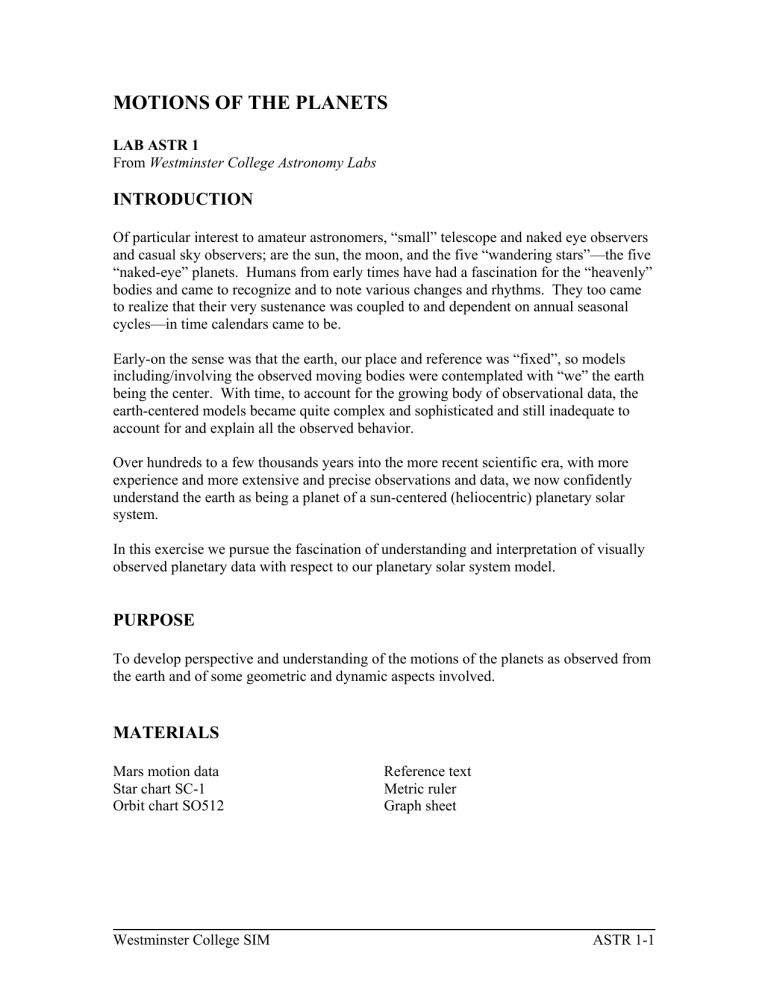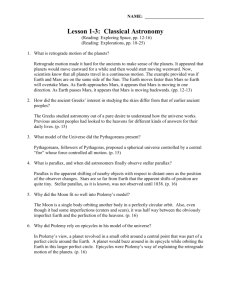MOTIONS OF THE PLANETS INTRODUCTION

MOTIONS OF THE PLANETS
LAB ASTR 1
From Westminster College Astronomy Labs
INTRODUCTION
Of particular interest to amateur astronomers, “small” telescope and naked eye observers and casual sky observers; are the sun, the moon, and the five “wandering stars”—the five
“naked-eye” planets. Humans from early times have had a fascination for the “heavenly” bodies and came to recognize and to note various changes and rhythms. They too came to realize that their very sustenance was coupled to and dependent on annual seasonal cycles—in time calendars came to be.
Early-on the sense was that the earth, our place and reference was “fixed”, so models including/involving the observed moving bodies were contemplated with “we” the earth being the center. With time, to account for the growing body of observational data, the earth-centered models became quite complex and sophisticated and still inadequate to account for and explain all the observed behavior.
Over hundreds to a few thousands years into the more recent scientific era, with more experience and more extensive and precise observations and data, we now confidently understand the earth as being a planet of a sun-centered (heliocentric) planetary solar system.
In this exercise we pursue the fascination of understanding and interpretation of visually observed planetary data with respect to our planetary solar system model.
PURPOSE
To develop perspective and understanding of the motions of the planets as observed from the earth and of some geometric and dynamic aspects involved.
MATERIALS
Westminster College SIM ASTR 1-1
Motions of the Planets
PROCEDURE AND ANALYSIS
1.
Mars Motion Data
On August 31, 2003 the planet Mars was positioned at a particularly close opposition to the earth. These close oppositions occur only once in fifteen years.
The combination of the movements of earth and Mars in their orbits at this time causes Mars to travel to what appears to be a strange path among the stars as viewed from the earth. Mars when at close opposition is a particularly desirable time for telescopic observation—many had their telescopes out at that time.
Plot the 2003 path of Mars on the graph sheet provided using the following data:
A
B
C
D
E
F
Date 2003 Right Ascenion Declination
Apr 1 19 h 14.6 m -22º 58´
Apr 11 19 h 41.3 m -22º 18´
Apr 21
May 1
20 h 7.3 m
20 h 32.4 m
May 11 20 h 56.6 m
May 22 21 h 21.7 m
-21º 25´
-20 º 22´
-19 º 12´
-17 º 50´
G
H
I
J
K
June 1
June 11
July 11
21 h 43.0 m
22 h 2.6 m
22 h 46.1 m
-16 º 35´
-15 º 25´
June 21 22 h 20.0 m -14 º 24´
July 1 22 h 34.7 m -13 º 36´
-13 º 08´
L July 22 22 h 53.9 m
Stationary July 31 22 h 56.0 m
M
N
Aug 1 22 h 55.9 m
-13 º 04´
-13 º 24´
-13 º 28´
Aug 11 22 h 52.9 m -14 º 13´
U
V
W
X
Y
Z a
O
Closest
Aug 22 22 h 44.4 m
Aug 27 22 h 39.3 m
Opposition Aug 31 22 h 35.0 m
P Sept 1 22 h 34.0 m
Q Sept 11 22 h 24.3 m
R Sept 21 22 h 17.7 m
Stationary Sept 30 22 h 15.8 m
S
T
Oct 1
Oct 11
22 h 15.8 m
22 h 19.1 m
Oct 22
Nov 1
22 h 27.8 m
22 h 39.6 m
Nov 11 22 h 54.2 m
Nov 21 23 h 11.0 m
Dec 1 23 h 29.5 m
Dec 11 23 h 49.2 m
Dec 22 0 h 12.0 m
-15 º 14´
-15 º 41´
-15 º 59´
-16 º 03´
-16 º 28´
-16 º 20´
-15 º 45´
-15 º 40´
-14 º 32´
-12 º 51´
-11 º 00´
-8 º 55´
-6 º 40´
-4 º 15´
-1 º 45´
+1 º 05´
Westminster College SIM ASTR 1-2
Motions of the Planets
(Identify each point by the letter indicated corresponding to the data and sketch in the path.)
2.
Label the celestial equator, draw in and label the ecliptic, draw in a few prominent stars in the background of Mars when in retrograde motion, label these stars and their constellation(s), and label the two stationary points and the ascending node.
3.
Describe the apparent path of Mars in your own words (include motions, directions, ….):
4.
What compass direction is Mars moving at the time of opposition?
5.
The orbit chart, SO512, is a plane view of the solar system through the orbit of
Saturn as seen from the north ecliptic pole.
Locate the present orbital position of each of the planets listed below from the heliocentric longitude data (current data to be provided).
Mercury 239 º (Data for June 15, 2007)
6.
Refer to the SO512 orbit chart. What are the heliocentric longitudes of Earth and
Mars at the time of opposition?
Earth Mars
The distance between the planets at this time is miles.
Note the centimeter scale at the bottom of SO512 orbit chart and that the radius of the earth’s orbit as drawn in one centimeter therefore providing a scale for the chart of centimeters corresponding to astronomical units (AUs). (One AU is about 93 million miles.)
Westminster College SIM ASTR 1-3
Motions of the Planets
7.
Planets are best observed when they are highest in the sky.
Name the planets presently best observed before midnight.
Name the planets presently best observed after midnight.
8.
Name the planets and their present relation to the ecliptic:
Above Below
9.
List the present distances of the planets from earth to the nearest tenth of an astronomical unit:
Mercury Venus
Jupiter Saturn
Mars
10.
Find the approximate next opposition dates for (show your work):
Jupiter Saturn
Westminster College SIM ASTR 1-4



